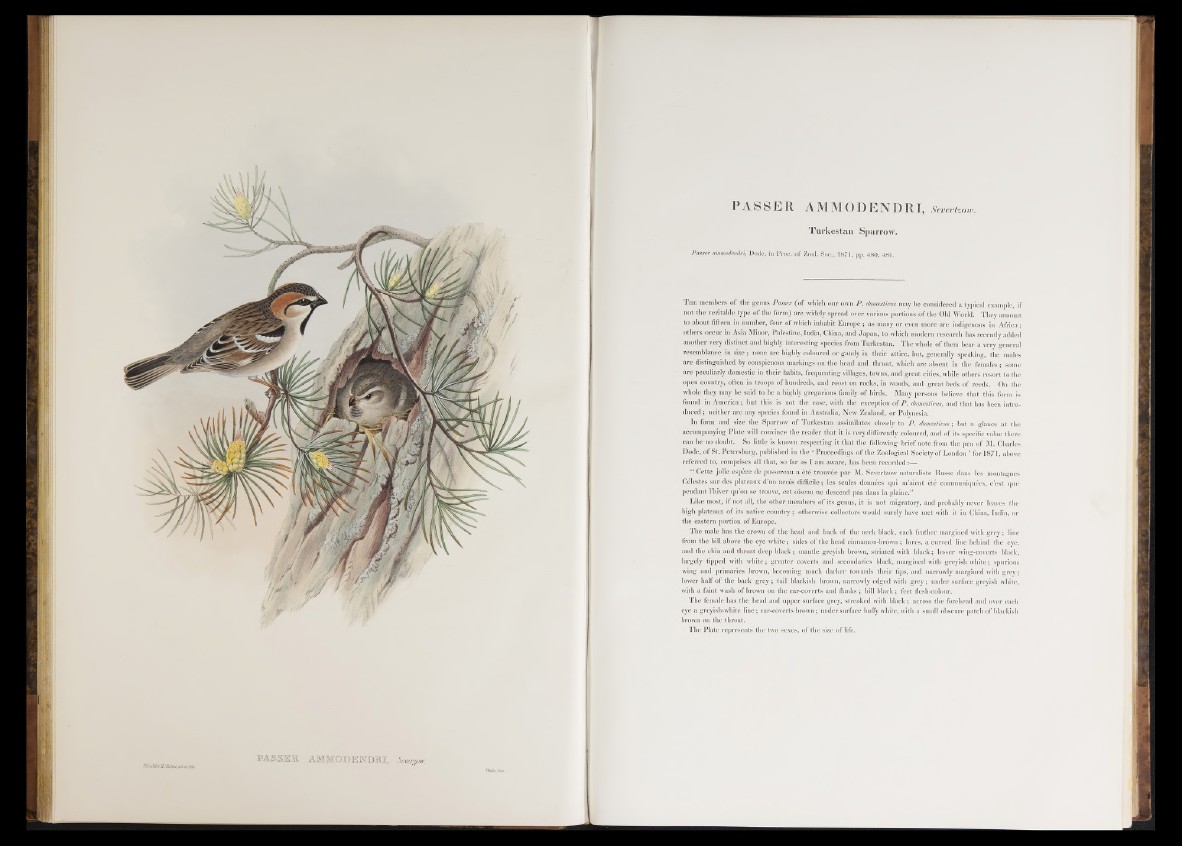
XòmJi/hSC&àtìa; 3tL et Ti/Ji/. PASSER AMMODEfflMRI, 'Sem&w.
WalUr.ìnip.
PASSER AMMODENDRI , Severtzow.
Turkestan Sparrow.
Passer ammodendri, Dode, in Pi-oc. o f Zool. Soc., 1871, pp. 480, 481.
T h e members of the genus Passer (o f which our own P . domesticus may b e considered a typical example, if
not the veritable type o f the form) are widely spread over various portions of the Old World. They amount
to about fifteen in number, four of which inhabit Europe ; as many or even more are indigenous in Africa ;
others occur in Asia Minor, Palestine, India, China, and Japan, to which modern research has recently added
another very distinct and highly interesting species from Turkestan. The whole of them bear a very general
resemblance in size ; none are highly coloured or gaudy in their attire, but, generally speaking, the males
are distinguished by conspicuous markings on the head and throat, which are absent in the females ; some
are peculiarly domestic in their habits, frequenting villages, towns, and great cities, while others resort to the
open country, often in troops of hundreds, and roost on rocks, in woods, and great beds of reeds. On the
whole they may be said to be a highly gregarious family of birds. Many persons believe that this form is
found in America ; but this is not the ease, with the exception of P. domesticus, and that has been introduced
; neither are any species found in Australia, New Zealand, or Polynesia.
In form and size the Sparrow o f Turkestan assimilates closely to P . domesticus ; but a glance at the
accompanying Plate will convince the reader that it is very differently coloured, and of its specific value there
can be no doubt. So little is known respecting it that the following brief note from the pen o f M. Charles
Dode, of St. Petersburg, published in the ‘ Proceedings o f the Zoological Society of London ’ for 1871, above
referred to, comprises all that, so far as I am aware, has been recorded
“ Cette jolie espèce de passereau a été trouvée par M. Severtzow naturaliste Russe dans les montagnes
Célestes sur des plateaux d’un accès difficile ; les seules données qui m’aient été communiquées, c’est que
pendant l’hiver qu’on se trouve, cet oiseau ne descend pas dans la plaine.”
Like most, if not all, the other members of its genus, it is not migratory, and probably never leaves the
high plateaux of its native country ; otherwise collectors would surely have met with it in China, India, or
the eastern portion o f Europe.
The male has the crown of the head and back of the neck black, each feather margined with grey; line
from the bill above the eye white ; sides of the head cinnamon-brown ; lores, a curved line behind the eye,
and the chin and throat deep black ; mantle greyish brown, striated with black ; lesser wing-coverts black,
largely tipped with white ; greater coverts and secondaries black, margined with greyish white ; spurious
wing and primaries brown, becoming much darker towards their tips, and narrowly margined with grey ;
lower half of the back g rey ; tail blackish brown, narrowly edged with grey; under surface greyish white,
with a faint wash of brown on the ear-coverts and flanks ; bill black ; feet flesh-colour.
The female has the head and upper surface grey, streaked with black ; across the forehead and over each
eye a greyish-white line ; ear-coverts brown ; under surface buffy white, with a small obscure patch o f blackish
brown on the throat.
' The Plate represents the two sexes, of the size of life.